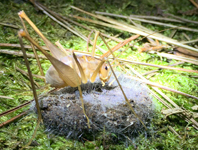Abstract
Sperchon fuxiensis Zhang, 2017 was published as a new species based on females alone. Two males of Sperchon were found in the same locality during our recent collection. The males resemble S. fuxiensis female in the integument pattern, excretory pore and the palps shape, but the chitinous plates of both dorsum and venter differ greatly. The males were paired with the female of S. fuxiensis using DNA barcoding, revealing unusual sexual dimorphism in the species. Descriptions and illustrations of the male of S. fuxiensis are given in the present study. Species identification based on the full-length DNA barcoding (658bp) of COI in water mites is also discussed.
References
Cook, D.R. (1974) Water mite genera and subgenera. Memoirs of the American Entomological Institute, 21, 1–860.
Ding, J.H., Sun, J.L. & Zhang, X. (2017) A new species of the water mite genus Sperchon Kramer, 1877 from China, with identifying Sperchon rostratus Lundblad, 1969 through DNA barcoding (Acari, Hydrachnidia, Sperchontidae). Zookeys, 707, 47–61.
Di Sabatino, A., Gerecke, R., Gledhill, T. & Smit, H. (2010) Chelicerata: Acari II. Spektrum Akademischer Verlag. Süßwasserfauna von Mitteleuropa 7/2-2, I-IX, 1–234.
https://doi.org/10.1007/978-3-8274-2266-8
Elías‐Gutiérrez, M., Valdez‐Moreno, M., Topan, J., Young, M.R. & Cohuo‐Colli, J.A. (2018) Improved protocols to accelerate the assembly of DNA barcode reference libraries for freshwater zooplankton. Ecology and evolution, 8 (5), 3002–3018.
https://doi.org/10.1002/ece3.3742
Glowska, E., Dragun-Damian, A., Broda, L., Dabert, J. & Dabert, M. (2014) DNA barcodes reveal female dimorphism in syringophilid mites (Actinotrichida: Prostigmata: Cheyletoidea): Stibarokris phoeniconaias and Ciconichenophilus phoeniconaias are conspecific. Folia Parasitologica, 61 (3), 272.
https://doi.org/10.14411/fp.2014.030
Hajibabaei, M., Spall, J.L., Shokralla, S. & van Konynenburg, S. (2012) Assessing biodiversity of a freshwater benthic macroinvertebrate community through non-destructive environmental barcoding of DNA from preservative ethanol. BMC ecology, 12 (1), 28.
https://doi.org/10.1186/1472-6785-12-28
Hebert, P.D., Stoeckle, M.Y., Zemlak, T.S. & Francis, C.M. (2004) Identification of birds through DNA barcodes. Plos Biology, 2(10), e312.
https://doi.org/10.1371/journal.pbio.0020312
Heron, J. & Sheffield, C. (2016) First Canadian record of the water mite Thermacarus nevadensis Marshall, 1928 (Arachnida: Acariformes: Hydrachnidiae: Thermacaridae) from hot springs in British Columbia. Biodiversity data journal, 4, e9550.
Jin, D.C. (1997) Hydrachnellae-morphology systematics a primary study of Chinese fauna. Guiyang, Guizhou Science and Technology Publishing House, 356 pp. (in Chinese with abstract of taxonom in English)
Krishnan, E.K.J. & Sebastian, C.D. (2015) Genetic and phylogenetic assesment of sexually dimorphic species, Diplacodes trivalis (Odonata: Libellulidae) using Cytochrome Oxidase I gene. Internatiional jjournal of pure & appliied biiosciience, 3 (2), 317–320.
Kumar, S., Stecher, G. & Tamura, K. (2016) Mega7: molecular evolutionary genetics analysis version 7.0 for bigger datasets. Molecular Biology & Evolution, 33 (7), 1870–1874.
Meyer, C.P. & Paulay, G. (2005) DNA barcoding: error rates based on comprehensive sampling. Plos Biology, 3 (12), e422.
https://doi.org/10.1371/journal.pbio.0030422
Pešić, V., Asadi, M., Cimpean, M., Dabert, M., Esen, Y., Gerecke, R., Martin, P., Savic, A., Smit, H. & Stur, E. (2017) Six species in one: evidence of cryptic speciation in the Hygrobates fluviatilis com- plex (Acariformes, Hydrachnidia, Hygrobatidae). Systematic and Applied Acarology, 22 (9), 1327–1377.
https://doi.org/10.11158/saa.22.9.4
Pešić, V. & Smit, H. (2016) Evidence of cryptic and pseudocryptic speciation in Brachypodopsis baumi species complex (Acari, Hydrachnidia, Aturidae) from Borneo, with description of three new species. Systematic and Applied Acarology, 21 (8), 1092–1106.
https://doi.org/10.11158/saa.21.8.10
Pešić, V. & Smit, H. (2017) Neumania kyrgyzica sp. nov. a new water mite from Kyrgyzstan based on morphological and molecular data (Acari, Hydrachnidia: Unionicolidae). Systematic and Applied Acarology, 22 (6), 885–894.
Pešić, V. & Smit, H. (2018) A second Palaearctic species of the genus Wettina Piersig, 1892 based on morphological and molecular data (Acari, Hydrachnidia: Wettinidae). Systematic & Applied Acarology, 23 (4), 724–732.
https://doi.org/10.11158/saa.23.4.11
Pešić, V., Valdecasas, A. & Garcia-Jimenez, R. (2012) Simultaneous evidence for a new species of Torrenticola Piersig, 1896 (Acari, Hydrachnidia) from Montenegro. Zootaxa, 3515 (1), 38–50.
Stålstedt, J., Bergsten, J. & Ronquist, F. (2013) “forms” of water mites (Acari: Hydrachnidia): intraspecific variation or valid species? Ecology & Evolution, 3 (10), 3415–3435.
Tachi, T. (2017) Description of the female of Ceromya glaucescens Tachi & Shima (Diptera: Tachinidae) and discovery of unusual sexual dimorphism in this species. Zootaxa, 4237 (3), 583–586.
https://10.11646/zootaxa.4237.3.10Toffoli, D., Hrbek, T., Araújo, M.L.G.D., Almeida, M.P.D., Charvet-Almeida, P. & Farias, I.P. (2008) A test of the utility of DNA barcoding in the radiation of the freshwater stingray genus Potamotrygon (Potamotrygonidae, Myliobatiformes). Genetics & Molecular Biology, 31 (1), 324–336.
Wiens, J.J. & Penkrot, T.A. (2002) Delimiting species using DNA and morphological variation and discordant species limits in spiny lizards (sceloporus). Systematic Biology, 51 (1), 69–91.
Yue, Q., Wu, K., Qiu, D., Hu, J., Liu, D., Wei, X., Chen, J. & Cook, C.E. (2014) A formal re-description of the cockroach Hebardina concinna anchored on DNA barcodes confirms wing polymorphism and identifies morphological characters for field identification. PLoS ONE, 9 (9), e106789.
https://doi.org/10.1371/journal.pone.0106789
Zhai, Q., Xue, G.X. & Li, M. (2017) DNA barcoding-based sexual association of Sovia lucasii and S. lii (Lepidoptera: Hesperiidae), with description of a new subspecies. PLoS ONE, 12 (8), e0183847.
https://doi.org/10.1371/journal.pone.0183847

